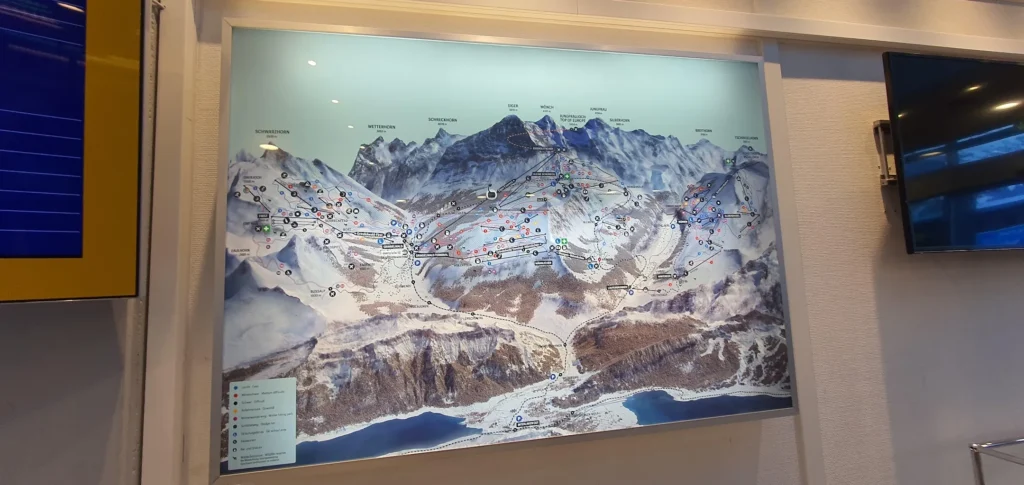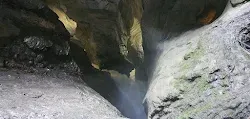The next excursion I suggest is to Lauterbrunnen.

Lauterbrunen is a small village in the Swiss Alps. It is known for its breathtaking views of the Alps and its picturesque waterfalls. It has been nicknamed the “Valley of 72 Waterfalls” because of its numerous waterfalls, making it one of the most beautiful places in Switzerland. Furthermore, it is often called “Little Yosemite” after Yosemite Park in California.






This small village is home to some of Europe’s most stunning natural wonders, including the iconic Eiger Mönch Jungfrau mountain range, best seen from Wengen, a mountain village reached by cable car.
We will visit Staubbach Waterfall, Trümmelbach Waterfall and the Mürren Waterfall.
From here, you can reach the Jungfraujoch, the highest train station in Europe. Construction of the railroad began in 1896 and was done entirely by manual labour: axes, shovels, and human labour. It took sixteen years to complete the railway, which officially opened in 1912.
In essence, the Jungfraujoch is not the same as the Jungfrau. Jungfrau is a high mountain, while Jungfraujoch is the saddle between Jungfrau and Mönch. Jungfraujoch is also the location of the highest railway station in Europe. Jungfrau and Jungfraujoch can be visited, but it requires more experience and effort as it is an alpine trek. Jungfrau is a mountain, 4,158 meters high, the third-highest mountain in the Bernese Alps after Finsteraarhorn and Aletschhorn and Jungfraujoch is a saddle between Jungfrau and Mönch, 3,454 meters high and it has the train station “Top of Europe” departing from Lauterbrunen via Wengen.
Many scenes were filmed at Piz Gloria for the 1969 James Bond 007 film On the Her Majesty’s Secret Service. Piz Gloria is located on top of the Schilthorn, a 2,970-meter peak in the Bernese Oberland, Switzerland, above the car-free village of Mürren.

Let’s hit the road. We pass through Wolfenschissen and then Dallenwil. You can also go up towards the village from the roundabout with goats. We continue forward. You can take the cable car or drive/walk to the top. The road by car is very narrow and steep and closes at the top with a parking lot where you can leave the car and continue on foot. From there you can admire the other valley towards Sarnen and walk up to the Stansenhorn, a journey that takes about 2 hours. Stansenhorn is a gorgeous peak, a 360 panorama from where you can see lakes, peaks like Pilatus, Titlis and mountain ranges, etc.

You can also reach Stanshorn from the city of Stans with a funicular and then take the famous cabriolet cable car.

Let’s continue our way. You can see the jet planes flying by as you approach the highway. Nearby is a small test airport and the Pilatus aircraft factory.
We head to the left, on the highway to Luzern and exit it to the right, also in the tunnel to Alpnachstad. We continue in the long tunnel until we see the small town on the right and Alpnacher lake on the left. Here is the station of the funicular that goes up the Pilatus peak.

We continue to the capital of the Canton of Obwalden, Sarnen. In Sarnen, there is, among other things, the History Museum of the Canton of Obwalden and an Aquapark.
Then we pass through Sachsen, which is on the shore of Lake Sarnen. From here, it is a half-hour drive to the geographical center of Switzerland.


Further, we go to Lungern and a long lake of the same name, which has the cleanest emerald-colored water. Also called the emerald green lake, clear as crystal, Lake Lungern is one of the most pristine lakes in the world: the water, which can reach 23° Celsius in summer, is of potable quality. The lake has a depth of 80 m. As points of attraction, I list the Peninsula and the Dundelbach Waterfall. You can take a cable car to go up and admire the panorama of the area.


This area is the largest marsh area in Switzerland. It stretches between Entlebuch and Lungerersee and Sarnersee. The site is an essential habitat for the highly endangered mountain grouse. It is the most extensive marsh landscape in Switzerland. At 130 square kilometers, the area is slightly larger than Lake Lucerne.
If you start from Lungern at the Melchse Frutt mountain resort, you will reach the most beautiful plateau in Switzerland. Here is also the longest toboggan run, more than 7 km long. Melchse Frutt can also be reached by car, but only in summer. At the top, you can walk for hours on that plateau, where an electric mini-car also operates. From the top, you can also go to Titlis and Engelberg in the summer. Some make this journey by bicycle (only if it’s easy 😊).


We continue through the Brünig Pass. On the right, we will see the Schwingen arena, the traditional Swiss sport of freestyle wrestling. https://de.wikipedia.org/wiki/Brünigschwinget
Also, there is a nice area of indoor restaurants and indoor sports. If you’re into target shooting with a rifle, come here.
https://www.bruenigindoor.ch/de/
You can find information about the park here:
We go further to the Caves of Saint Beatus. Until there we reach Lake Brienz on the shore of which we will travel. We will travel along the southern shore, but I have several tourist attractions up to here.
Beatus of Lungern, also known as the honorary apostle of Switzerland, Beatus of Beatenberg, or Beatus of Thun, was probably a legendary monk and hermit of early Christianity and is venerated as a saint. Beatus is primarily remembered as the first apostle of Switzerland. According to legend, the caves provided a safe haven for Saint Beatus after he conquered and banished a fire-breathing dragon that resided there. The cult of Beatus was widespread in the Middle Ages and even survived the hostility of the Reformation period, when pilgrims were driven from his cave by Zwinglian Protestants. His relics and the center of his cult were transferred to the chapel in Lungern, Obwalden. The caves are around 1 Km.

We head south towards Lauterbrunnen at the Staubbach waterfall.
From here you climb up to the waterfall, and you can reach it in about 10 minutes. You can see the traditional Swiss houses and the Lauterbrunnen monastery. Etymology: The local explanation is that the name Lauterbrunnen means “many springs”, using a modern meaning of the German word lauter. It can also mean noisy or bright. Lauterbrunnen has become an important tourist destination and is connected to Interlaken by the Bernese Oberland Railway and is the start of the Wengernalp Railway, which leads to Kleine Scheidegg. From there starts the Jungfrau Railway, the highest railway in Europe and a gateway to the Jungfrau-Aletsch protected area. The Great Aletsch Glacier (to the south) is the largest and longest glacier in the Alps (22 Km).
The place where 007 was filmed is not far from here, on the top of the Schilthorn (Piz Gloria): https://schilthorn.ch/en/Infos/News
https://en.wikipedia.org/wiki/Piz_Gloria
The Grindelwald resort is also nearby https://grindelwald.swiss/de/winter/
I will also post a link with attractions in Grindelwald: https://fullsuitcase.com/grindelwald-first/
Then we go to the Trümmelbach waterfall, which can be visited on several floors. The stream that drains the walls of the glaciers of the Eiger, Mönch and Jungfrau mountains has here washed a gorge in the face of the rock, which is very narrow. It transports up to 20,000 liters of water per second and 20,200 tons of sediment annually. The upper falls inside the mountain could only be accessed through galleries and tunnels. In this gorge, the stream falls in ten waterfalls, overcoming a height difference of 140 meters. Trümmelbach has a catchment area of 23 square kilometers, half of which is covered with ice and snow.


We go further to the village of Stechelberg, where you can see the Müren waterfall.
Then we return to Interlaken, where we can visit the city center and a park http://www.jungfraupark.ch/.
Then we visit the city of Thun and the castle of Thun.




On the way back, you can also visit Ballenberg, where the village museum is located. https://ballenberg.ch/en/
Train travel options: Swiss Travel Pass, Flex Pass and Half Fare Card will give you a 50% discount on mountain tours. In the Jungfrau region, these passes cover your transport to Wengen. For example, the Swiss Travel Pass costs around 230 CHF for 3 days.

